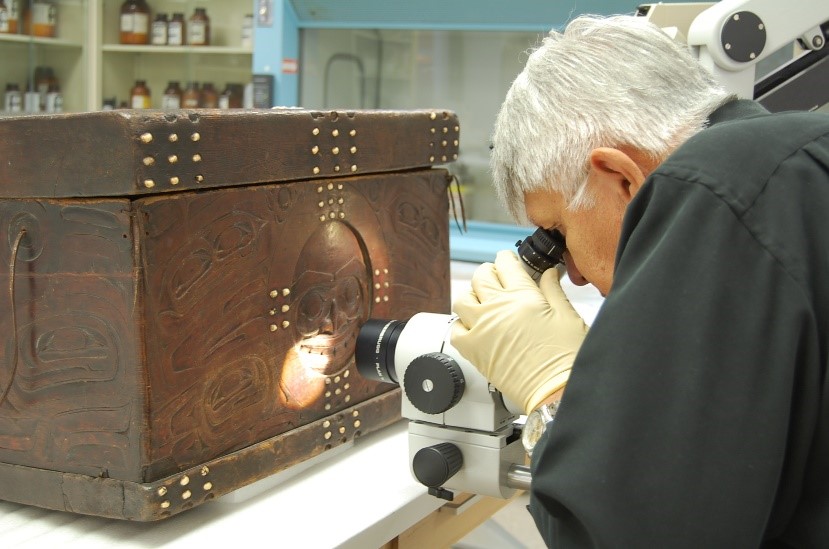Improving a Museum's Information about its Collections
CASE STUDY
Record Keeping for a Long-Term Collaborative Project: The Acoma Collection Review at the Indian Arts Research Center at the School for Advanced Research
Jennifer Day, School for Advanced Research
A central component of the collection review process has been planning for and carrying out record keeping so that that information gathered during the sessions can be easily retrieved and understood in the future, even after all the involved staff members have left. At IARC, record keeping is realized primarily through a collections management database, though paper-based records are still common for many institutions. All staff have access to the database, and it’s their primary source for information about objects in the collection.

At IARC, the collection review process is broken down into three main parts, and each part contributes to maintaining thorough and accurate object records. These steps would likely vary at other institutions and should be formulated with each museum’s needs, goals, and record keeping realities in mind.
Part 1. Before the Review Sessions: Data Entry
The goal of this part of the process is to input all known information about each object in the database so that useful object reports can be printed for use during the review session. All known information about makers, provenance, materials used, stories linked to the piece, or conservation that has been done on it in the past are added to the record ahead of the first visit. Having the complete known story about a piece available during the review session makes each conversation as productive as possible and saves time. This level of data entry takes months of staff time, so it’s carefully planned for in the timeline of each review project.
Part 2. During the Review Sessions: Taking Notes and Making Voice Recordings
These steps take place during the review sessions. Good notes are vital to the next part of the process, which is the first round of post-visit data entry. Permission is sought from each participant to make voice recordings before the sessions begin. (Participants can request the recorder be shut off during sensitive discussions.) The recordings are referred to when a discrepancy or deficiency is observed in the notes during the post-visit data entry phase. Some communities might not feel comfortable with voice recordings, in which case good note taking is even more important.
Part 3. After the Review Sessions (In Three Steps)
- Post-Visit Data Entry: Staff try to complete data entry as soon as possible following a collection review visit, so that the memory of the session is as clear as possible. Certain fields in the database have been identified for inputting the new information, and they are used consistently so that staff always know where to find it. A combination of notes and voice recordings are used to ensure the accuracy of the data that is entered. Though this is a short step to describe, it’s often one of the longest steps in the entire collection review process, depending on the number of objects involved and the amount of detail that the community participants wish to see added to the records. As such, this step is planned for accordingly during project development.
- Data Review: Following the post-visit data entry, the newly added information is shared with the community representatives to ensure that it’s accurate and culturally appropriate. The goal is for IARC staff and the community participants to “be on the same page” regarding what information is shared with potential users. As with the review sessions with the physical objects, the data is reviewed during visits by community members to IARC, or sometimes IARC staff goes to the community to meet with the representatives.
- Final Data Entry: During this step, any needed edits, changes, or additions identified during the data review are made to the records.
During the collection review process at IARC, staff has learned that a few items are culturally sensitive. These are items that may require access and publication restrictions and special handling and storage instructions. The special instructions are recorded during the Post-Visit Data Entry phase, to guide staff in culturally appropriate stewardship. When items require further evaluation by cultural authorities, or possible NAGPRA repatriation, those situations are also noted so they can be planned for in the near future. Contact information is recorded for tribally designated cultural authorities who staff should contact when questions arise about culturally sensitive items.
In addition to object records, IARC staff also maintain an Event record for each review session. The record contains a list of all attendees (both IARC staff and community representatives) and a list of all objects reviewed during the session. It also includes where and when the session took place, a summary of the purpose of the session, and a summary of topics discussed. Future staff can use this record to understand the goals and outcomes of the collection review projects.
Photography and recording permission forms are another set of records that are maintained. At IARC, these are kept in the files with the other paper documentation resulting from each session. This way they can be located easily when needed.
Record keeping methods will vary from institution to institution, though they will typically involve some combination of paper-based records and database records, much like at IARC. Record keeping and data management are truly integral parts of planning for any community visit or long-term collaboration, and they should be given their due consideration and time during the process. Integrating adequate time for them in the project work flow will ensure thorough and accurate records that will be of maximum help during community visits and continue to serve staff, community members, and other researchers far into the future.
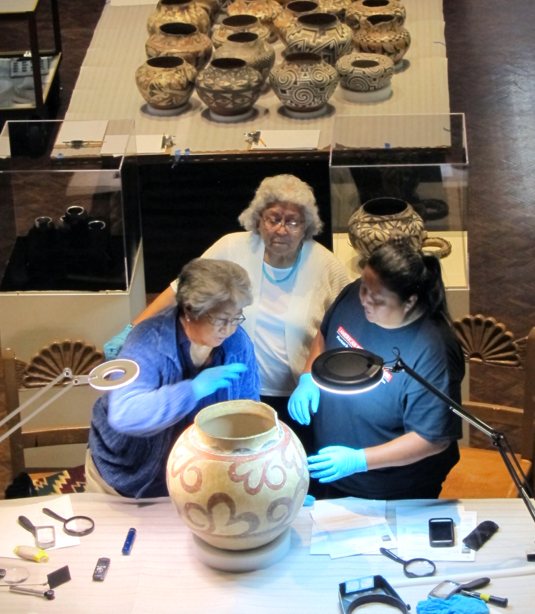
Three community participants view a large storage jar, Acoma Collection Review, June 2015. L-R: Pearl Valdo, Dolores Lewis Garcia, Brenda Valdo.
CASE STUDY
Setting the Record Straight
Cynthia Chavez Lamar and Jim Enote
School for Advanced Research and A:shiwi A:wan Museum and Heritage Center
In 2008 the A:shiwi A:wan Museum at Zuni, New Mexico and the School for Advanced Research (SAR) in Santa Fe embarked on a collaborative partnership to “set the record straight” about Zuni items in SAR’s collection. The program had two major components: (1) Systematically review the entire Zuni collection held at SAR (over 1000 items); and (2) Provide SAR’s digital catalog records of Zuni items to Zuni. Jim Enote, A:shiwi A:wan Museum and Heritage Center Director, and Cynthia Chavez Lamar, then the Indian Arts Research Center Director at SAR, led the initiative that incorporated the expertise of Octavius Seowtewa, head of the Zuni Cultural Resource Advisory Team, and SAR’s collections staff.
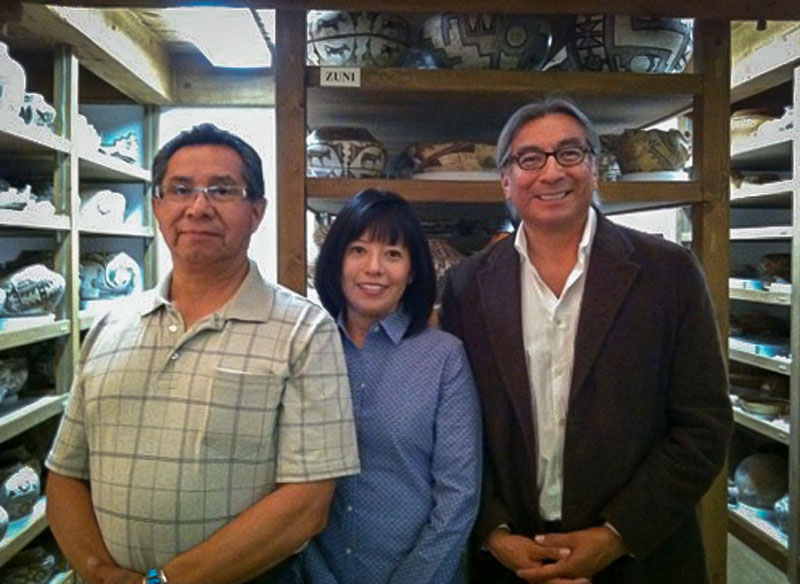
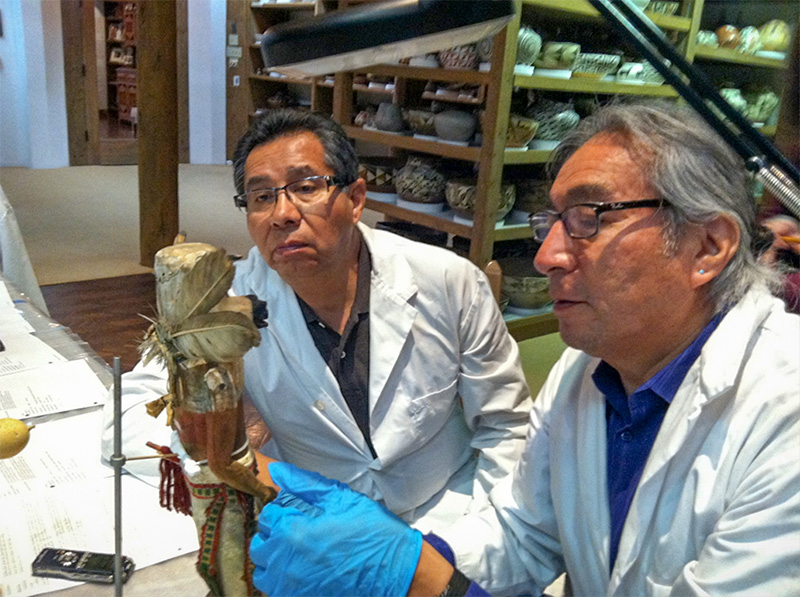
Octavius Seowtewa and Jim Enote at work
The intention of these collection reviews was to correct misinformation and provide relevant contextual information about Zuni items in SAR’s collection as well as provide instructions on care and handling practices. Establishing more accurate and complete information benefits SAR and future researchers because it provides them with a Zuni perspective. Zuni also benefits in that misinformation gets corrected and will not continue to circulate as misinformation. This is a point that Jim continually reiterates as a reason this type of work is important. He states: “Considering access to new information media, we want Zunis to have the right information about these things in the future. When young Zunis look at things in collections, and if the things in those collections are misidentified or lacking information, then those young Zunis are not learning about their heritage and their culture in the right way. We want to set the record straight.”*
Controlling how knowledge about Zuni collections is documented and interpreted is a strong reason for Zuni’s collaboration with institutions stewarding Zuni collections.
*Cynthia’s personal communication with Jim, 2010.
CASE STUDY
Community Experts
“Pinerrluirturluki Kesianek/Always Preparing Our Men for Success”
Yup’ik elders visit to the National Museum of the American Indian, October 27-November 4, 2012
Ann Fienup-Riordan, Independent Scholar
During the last week of October 2012, three Yup’ik seamstresses – Albertina Dull (age 94), Elsie Tommy (age 90), and Martina John (age 74) traveled with Ruth Jimmie, Calista Elders Council (CEC) director Mark John, University of Alaska Fairbanks student Abby Moses, and anthropologist Ann Fienup-Riordan to Washington, DC to work in collections at both the NMAI and NMNH. None of the elders spoke English and none had ever left Alaska, let alone traveled so far from home. They were all thrilled to be coming to Washington, where during the last days of their visit they were joined by two granddaughters and four great-grandchildren.
Our trip was made even more exciting by the participation of April Dutheil and Jordan Konak of the Arviat History Project in Nunavut. Both April and Jordan had traveled to DC for the Inuit Studies Conference and planned to stay with us an extra day to train Abby in social media and sharing our trip with relatives and friends back in Alaska. As it turned out, April and Jordan were with us for half the trip and helped Abby share photos, videos–especially the run-away hit Yup’ik Elders Gang–and observations through the Calista Elders Council website and Facebook page, Yup’ik Elders. Thousands of Yup’ik people could see their elders exploring museum collections, laughing and smiling in the process.
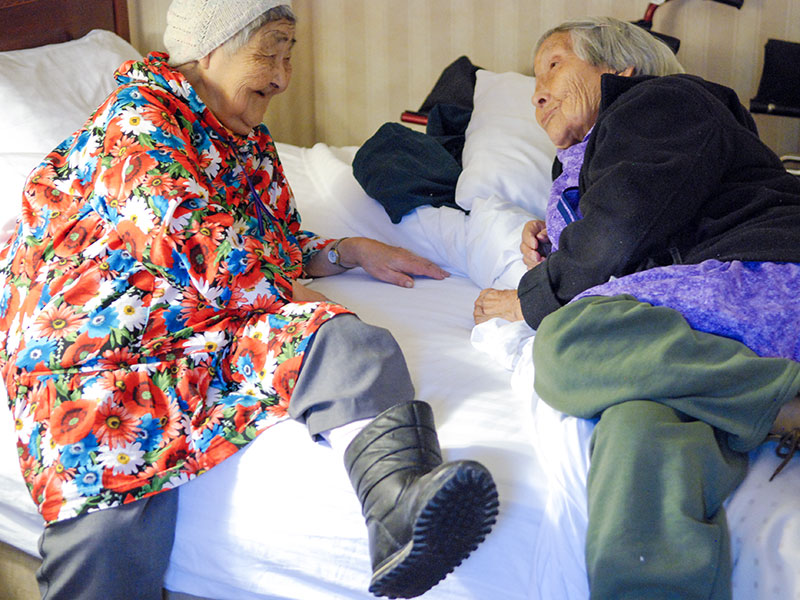
Our trip got off to a windy start with the arrival of superstorm Sandy. Although this was worrisome in prospect, our days at the Holiday Inn were filled with story-telling and sharing. We held a small “sewing gathering” in Albertina and Elsie’s room, where the women spoke of their experiences growing up and how they learned to sew. Martina, who had brought skin boots to sell at the museum, showed how to sew boot soles as well as the measurements for the upper parts and their decorative features.
Although Sandy shortened our time in collections, it allowed the women to rest and reflect after a long trip and prior to a much-anticipated experience.
At the end of the trip, Mark John noted that what most impressed him was the elders’ knowledge. They looked at objects and could tell the materials they were made from, who they were made for. More than that they noticed that some things were made with love, while other things were “just made.” He also noticed how the elders’ voices got stronger when they were talking about the past, which they could clearly see.
Mark talked about our need to continue to document these things from hunting the animal, to preparing the material, to the finished product. Again, he feels the urgency of our work. The elders appreciated seeing things from their area but also other objects. They noticed with interest how they were differently made, as for example a gut parka at NMAI made with horizontally sewn strips rather than the circular sewing method used on Nelson Island.
I asked Ruth Jimmie what she had liked best about our trip, and she said it was seeing the old things in collections. The city itself was OK, but our days in collections stood out as a once-in-a-lifetime experience.
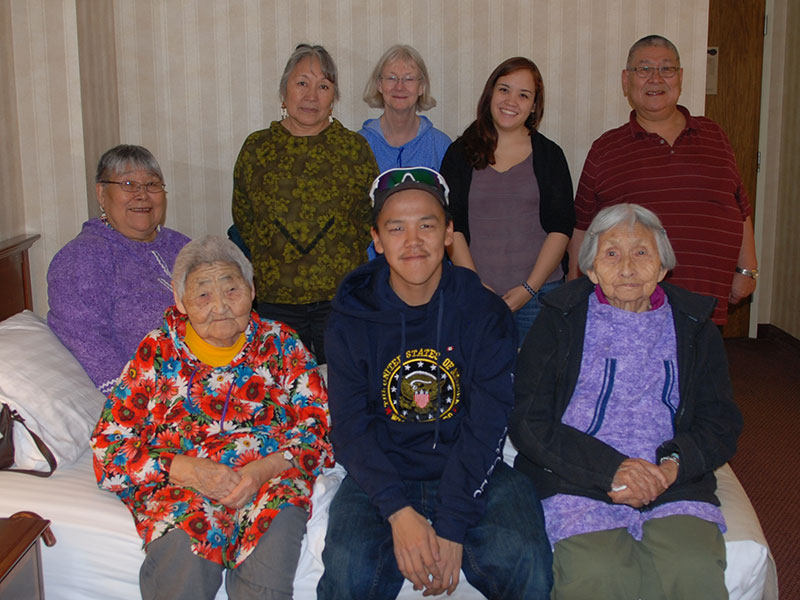
Home in Alaska, Alice Rearden set to work transcribing the fifteen 90-minute audio tapes recorded during our trip. As she worked she kept track or further questions we need to ask the elders when we see them again in Anchorage. Ann also pulled together information on sewing and clothing construction shared by elder women during previous gatherings. A great example is the story Paul John told many years ago about a flying parka. It continues to amaze me how, thanks to new questions, one can revisit transcripts and learn so much more.
The most satisfying thing for me during our trip was to share elders’ joy in revisiting their past and the wonderful ways in which they shared that joy with us and with one another. I don’t believe this would have been possible without the warmth and friendliness of all the women and men we worked with both at NMAI and NMNH, especially Landis Smith who smoothed our way into collections. Sharing rides, food, jokes, and enthusiasm, I’ve never worked in collections with such a great group of people.
Thanks not only to what the elders shared but how they shared it, the book that is growing out of our work together will highlight finely crafted clothing imbued with the love and compassion with which they were created.
CASE STUDY
Correcting the Record Through Collaborative Examination
Correcting the Record Through Collaborative Examination
Michele Austin Dennehy, George Bennet, Sr., and Landis Smith
Tlingit artist, Tlingit artist, and National Museum of Natural History
George Bennett Sr. (T’ak Dein Taan) and his son James Bennett (Wooshkeetaan), both Tlingit artists, visited the Anthropology Conservation Laboratory at the National Museum of Natural History while they were at the Smithsonian as part of the Native American Community Scholars program of the Office of Fellowships. With the Anchorage Project conservators and interns, the Bennets reviewed a group of Tlingit objects selected for exhibit.
